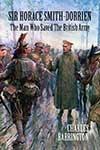|
SIR HORACE SMITH DORRIEN
THE MAN WHO SAVED THE BRITISH ARMY
by Charles Barrington

|
How often have spats between commanders influenced the course of military history? Regrettably rather too often and possibly never as nakedly as that between Field Marshal Sir John French and Lieutenant General Sir Horace Smith-Dorrien over Smith-Dorrien’s decision to take a stand against von Kluck’s First Army on 26th August 1914 at Le Cateau on the Retreat from Mons. Charles Barrington has written an excellent new biography of Smith-Dorrien which, correctly, majors on this, his most important legacy.
Smith-Dorrien’s career before the outbreak of war that summer had been as successful and operationally varied as any late Victorian British officer. An infantry officer commissioned into the Sherwood Foresters in 1877, he had escaped the massacre at Isandlwana, served in both the Egyptian campaign and on the North-West Frontier as well as with distinction in the Boer War. From 1908 to 1912 he had commanded Aldershot Garrison, then the leading peacetime command which was both the centre of British Army training and the nucleus of what deployable forces were available. He had taken over the command from French, a man with whom he had previously clashed in South Africa where they had respectively commanded infantry and cavalry divisions. Although they had parted friends, French appears to have harboured a certain jealousy for Smith-Dorrien’s success and the favour he enjoyed with Kitchener. This festered so that when Smith-Dorrien instructed the Aldershot cavalry regiments to concentrate as much on dismounted musketry, as opposed to the more traditional cavalry tactics, French was incandescent.
The British Expeditionary Force, commanded by French, deployed to Belgium in August 1914 with two corps. 1 Corps was commanded by Douglas Haig, who had been French’s chief of staff in South Africa, and 2 Corps by the greatly respected Sir James Grierson who died of a heart attack on a train on 17th August. French wanted Herbert Plumer to replace him but Kitchener insisted on sending Smith-Dorrien. He arrived on 19th August just as the German pressure forced the BEF to start withdrawing from the forward positions they had established in front of Mons. The BEF was seriously outnumbered and, despite a spirited defence marked by the effectiveness of its rifle fire, French, under strict instructions not to lose the one deployable British army available, decided to withdraw west, not least because a gap was opening on his right flank as Landresac’s 5th French Army fell back having been defeated at Charleroi.
The subsequent Retreat from Mons has justifiably become one of the British Army’s celebrated campaigns; by 1918 the Mons Star was valued as highly as an MC. Yet it nearly turned into a disaster. The BEF was exhausted, many of its soldiers unfit reservists who had been in action almost continually since their deployment, and the weather was stiflingly hot. Haig’s 1 Corps pulled back through Landrecies, from whence Haig made an undignified exit when he thought he faced the German main effort. In fact, that fell on Smith-Dorrien’s 2 Corps which von Kluck believed constituted the whole BEF. Realising that he was in severe danger of being overwhelmed, Smith-Dorrien ignored French’s orders to continue the retreat and, on 26th August, turned his corps to face von Kluck along the Roman road that runs from Cambrai to Le Cateau. The resulting battle cost 2 Corps approximately 5,000 casualties and resulted in the loss of 36 guns despite some extraordinarily brave attempts by the Gunners to save them which led to them winning three VCs. Yet it achieved its aim, delaying von Kluck who was unable to close with the BEF again during the rest of the 200-mile retreat and allowing the BEF both to survive as an entity and play a full part in the Battle of the Marne.
Although most observers at the time, and historians subsequently, believed that Smith-Dorrien had made a bold and successful decision, French remained furious that his orders had been countermanded. In 1916 he had Smith-Dorrien sent home and he was never given another field command. Haig subsequently assumed the supreme command, a position which many thought should have gone to Smith-Dorrien. Then in 1919 French published his memoirs in which he attempted to annihilate Smith-Dorrien’s reputation even further, fiercely criticising his conduct at Le Cateau and vastly exaggerating the losses. It was such an obviously personal and venomous attack that inevitably it was French’s reputation that suffered.
Charles Barrington’s very well researched and readable biography does not deny that Smith-Dorrien could be difficult and tactless; his Chief of Staff in 2 Corps threatened to resign when he was appointed saying he was impossible to work with. But Barrington argues convincingly that Smith-Dorrien’s performance in South Africa and in France demonstrates that he was a highly competent formation commander who spoke his mind but had the enduring trust of his soldiers. This is also an important book as it shows the danger of a very senior officer allowing personal grudges to stand in the way of tactical decisions. Such behaviour was evident again in the Second World War and is sadly still present across many armies today. Senior commanders have a duty to get on with each other.
Barney White-Spunner
New Generation Press |
|

